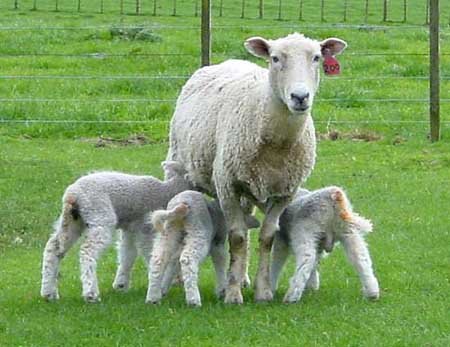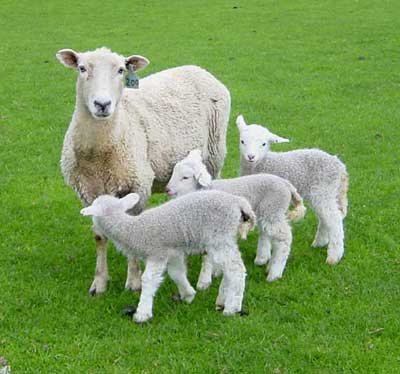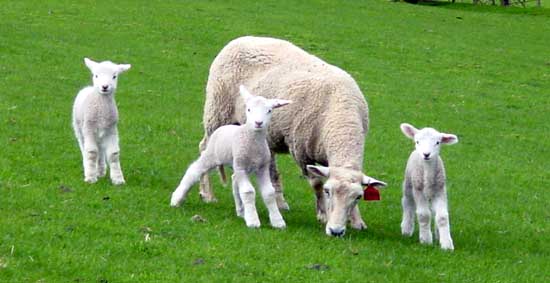
Management of Triplet Ewes - A summary of information
By Dr. Jenny Burton, Cambridge farmer, member of Northern Sheep Council
The following information relates to ewes carrying triplet lambs, the lactation of those ewes and the requirements of the lambs for survival. Both extensive and intensive sheep farming is practised in New Zealand. The data in this summary has been provided by both sheep farmers and a review of the literature.
The successful management of triplet ewes and their lambs to weaning involves many factors. The importance of adequate nutrition cannot be over emphasised. However other factors are also important if optimal results are to be achieved.
- Prematinq - The use of teasers prior to putting out the ram to achieve a maximum number of ewes mated in the 1" round may have benefits. Flushing ewes prior to mating is recommended.
- Mating - should correspond to lambing with the spring flush. Ewes lambing at this time produce more milk compared to ewes lambing either earlier or later. Ewes with triplets need to produce as much milk as possible. There are breed differences in the amount of milk produced. A mating harness with coloured crayon on rams identifies the time of mating of ewes, and enables a farmer to divide mobs into different groups prior to lambing (based on expected lambing dates).
- Early pregnancy - Good placental development is important for foetal growth and lamb birth weight. Feed to maintain good body condition during early pregnancy. For 8 weeks after mating don't allow weight loss. A live weight loss of 2.5 Kg over the first 60 days (approx. 40g/day) restricts placental development and foetal growth.
- Mid pregnancy - continue to maintain good condition and body weight. Monitoring the condition score of ewes identifies light ewes and ewes that are on the way to become over fat. It may be necessary to put these into separate groups to adjust their feed requirements. Increasing feed levels in light ewes will increase foetal weight.
- Late pregnancy - Ewe energy requirements are increasing. The foetuses grow about 70% in the last third of pregnancy. Ewe live weight gain during the last 6 weeks of pregnancy is associated with an increase in birth weight in twins. An increase in birth weight may occur in triplet lambs. This is dependant on nutrient uptake by the placenta and foetal tissues. Feed must be of good quality to meet energy demands.
 One trial found that sward height was important with 6cm giving all triplet lambs in a set, the best chance of a good colostrum intake. Another trial found that colostrum was related to litter size but did not reflect the differences in nutrition of ewes in late pregnancy. A low sward height means that a ewe spends more time grazing.
One trial found that sward height was important with 6cm giving all triplet lambs in a set, the best chance of a good colostrum intake. Another trial found that colostrum was related to litter size but did not reflect the differences in nutrition of ewes in late pregnancy. A low sward height means that a ewe spends more time grazing.- Break-feeding high quality pasture controls daily feed, but is time consuming.
- Ewes carrying 3 plus lambs can lose their appetite in very late pregnancy, and may therefore require concentrates. Supplements such as nuts or grains (e.g. barley) can be fed to triplet bearing ewes prior to lambing. This means intake is not limited by feed bulk. Ewes that are not used to supplements may not initially eat them. The feeding of hay or straw is not recommended because of their low ME values and high bulk.
- After lambing, supplements can be fed to triplet ewes, but mismothering may occur when ewes leave their lambs to access the feed. Feeding barley to ewes with singles and giving the good quality pasture to ewes with triplets is one way to manage this. Ewes on supplements require access to water.
- Don't tighten the feed levels. This does not reduce dystocias or bearings. It may result in sleepy sickness and will decrease colostrum/milk production. Triplet ewes in late pregnancy/ early lactation on fresh forage are likely to be in negative energy and protein balance. A high protein diet for the ewe may increase lamb survival as long as palatability is high.
- A trial showed that ewes on a low ME level in the last 8 weeks of pregnancy had triplets that weighed 26% less than ewes on a high ME level. The mortality for the triplet lambs from the ewes on the low ME level was 87% more than the triplet lambs from the high ME fed ewes. The nutrition of the ewes also affected the mean daily weight gain of the lambs.
- There may be a large variation in the total weight of triplet lambs born. In one study the range was 6Kg - 18.5Kg (per set).
- Lactation - It has been shown that ewes rearing 3 lambs produce more milk than those rearing 2 lambs. These ewes are more efficient at conversion of feed to milk. Daily milk yield does not peak until after 10 - 14 days or more, and that peak may last several days.
Feeding Levels - Theoretical Calculations

Calculations found in the literature, for the feed requirements of triplet ewes in pregnancy and lactation, vary because of factors such as ewe live weight at tupping, ME of pasture, milking ability of the ewe (i.e. peak of lactation - time and amount, and period of lactation peak), DM/Ha of pasture and weight loss of the ewe, weaning weight of lamb, and birth weight of lamb.
Theoretical calculations for a triplet ewe (weight 65Kg at tupping) during pregnancy, on pasture, range from 2.4 - 2.8 Kg DM/day at the time of lambing. In late pregnancy abdominal space is limited by three growing fetuses. Rumen volume/capacity is also limited. Higher concentrations of NEFA's and B-hydroxybutyrates in triplet ewes (compared to twin ewes) indicate that triplet ewes are using their body reserves more to meet requirements.
After lambing the triplet ewe continues to require an increasing amount of energy/day to peak lactation. Calculations (based on 65Kg ewe) for the peak of lactation range from 2.5 - over 3 Kg DM/day if pasture ME is approximately 11.0.
A recent calculation has found that the energy requirements for a triplet ewe peak at the end of pregnancy (at 4.5% - total DM/day as a percentage of body weight, then drops following lambing to 2.4% and gradually increases to 3.9% peak which lasts over 3 weeks).
The feed quality must therefore be high, otherwise the ewe simply won't be able to get enough energy. When the energy is low and grass intake is not adequate, the ewes will lose weight and the lambs will not get enough milk (or milk/ grass) for optimal growth.
Pasture Quantity And Quality
It is important that the grass does not become too short.
A trial with different sward heights from 2 - 8cm, found best results with a sward minimum of 4cm of pasture during mid to late pregnancy. Ewes grazing 2cm during pregnancy were lighter at day 132, at lambing and at weaning. Lambs born to ewes on sward heights of only 2 cm had small girths and were lightest at birth. Also, on a sward height of only 2 cm in late pregnancy, ewes had lower calcium and magnesium, and higher NEFA's and BOH levels (compared to sward heights 4cm, 6cm, and 8cm). The results also suggested that there was no need to feed above 4 cm in pregnancy or lactation to optimise lamb weaning weights and lamb survival. Weaning weight of the triplet lambs was 23Kg (day 87).
Another trial had no feed restriction on ewes and lambs during lactation with pasture covers (improved ryegrass/ clover) maintained between 1800 - 2600 kg DM/ha. The average growth rate of the triplet lambs was 380g/day to 12 weeks. The best set of triplets grew at 396g/day and averaged 37.4 Kg at 12 weeks.
At lambing time, on a low feed level, ewes are more likely to move away from the birth site earlier.
Careful use of nitrogen can be used to boost pasture growth. If the quality of grass is poor, although fertilizer, subdivision and good grazing management has taken place, it may be worthwhile considering pasture renewal. Such high quality paddocks could be used specifically for triplet ewes and their lambs.
- Shelter - The main cause of triplet lamb mortality is a combination of exposure and starvation. A significant proportion of newborn lambs use shelter if available. The position of the shelter (not near roads or human activity), and the type of shelter is important. Ewes seek objects such as big trees and sheds, tall grass, flax, fallen logs and materials on fence lines. Shelter should also be at elevated positions, or along and within paddock margins. Shelter is used most on the 1st day after lambing, followed by a gradual decline in the following days. The use of shelter is greatest as temperature decreases and as rain and wind increase. Triplet lambs may suffer from hypothermia (and then death) with frosts, and with rain and wind, even if the temperature is 10-15C.
- Space - Lamb at a lower stocking rate, 5 - 10 ewes per hectare has been suggested. However on intensive farms more ewes per hectare might be grazed, but good shepherding is required. Ewes with triplets may lamb up to 10 days before the expected lambing date. Set stocking of ewes should therefore be 2 weeks before the expected lambing date so that ewes can find a suitable site.
- Triplet lambs may wander while the ewe is giving birth to another lamb. Lambs follow any ewe, and are easily confused. A ewe parted from a lamb, loses the scent in a short time, after lambing. She then may not accept it when /if it returns.
- Farmers are able to adjust feed levels and density of ewes/lambs after lambing and/or at docking by combining groups or shedding off ewes and lambs to another paddock. Cattle can be used with single ewes/lamb.
- Lambing Dates - Separate into different lambing date groups if possible. For example those ewes mated in the 1s' half of the first cycle; 2nd half of the first cycle; second cycle. Older triplets sometimes feed off ewes that have recently lambed, or have young/small lambs.
- Slope - When ewes lamb on steep slopes, the majority of lambs slip from their birth sites. Ewes giving birth to triplets may not follow a new born lamb down a hill when another lamb is due to be born. The newborn lamb is unlikely to climb back to the mother.
Triplet Ewes/Lambs Alone Or Combined With Others?

Some trial work and the experience of farmers with high weaning percentages suggest that triplet ewes/lambs are best by themselves. Data from one trial says that twin and triplet ewes do not need to be separated to achieve optimum lamb production (triplet lamb weaning weight = 23 Kg; twin lamb weaning weight = 27 Kg). Lamb losses (in this trial) to weaning were 14% in twin born lambs and 32% in triplet born lambs. This compares with farmers on intensive properties who are achieving 230% or more at docking when triplet ewes are not combined with single and twin bearing ewes.
HEALTH - Checklist
Selenium - deficiency results in white muscle disease in lambs Toxoplasmosis - vaccine available
Campylobacteriosis - vaccine available
Clostridial Diseases - 5 in 1 and 10 in 1 vaccines are available
Salmonella Brandenberg - vaccine available (South Island)
Leptospirosis - serovar pomona from wild pigs causes death of lambs where infected pigs move through lambing paddocks. Vaccine is available.
Brucella ovis - ensure rams have been checked and are free of disease.
Iodine - supplementation prevents goitre in iodine deficient areas and in areas where goitrogens in pastures/crops (esp. kale) prevent inorganic iodide uptake by the thyroid gland. Subclinical iodine deficiency may be present on some farms. A mean thyroid to bodyweight ratio of more than 0.4g/Kg (10 lambs or more) and high perinatal mortality suggests subclinical iodine deficiency
Bearings - these occur more in ewes carrying triplets. Avoid steep slopes in last month of pregnancy, sudden change from short to long dairy cow type pasture, swedes, and possibly salt licks.
HETEROSIS - Hybrid vigour can increase lamb birth weight by 6%. Crossbred triplet lambs are likely to be heavier than purebred lambs.
SHEARING - Trials have shown that mid pregnancy shearing increases the birth weights of twin-born lambs but may have no effect on the birth weight of triplet-born lambs. If mid pregnancy shearing in cold weather use a cover comb, and then provide shelter and feed. Removal of a long fleece may lessen the chance of a ewe becoming cast.
Pre-lamb crutching/belly or half belly decreases the chance of lambs ingesting infectious bacteria on dirty wool while trying to find a teat. This may result in Watery Mouth in lambs.
DISTURBANCE - On extensive sheep farms, in general, ewes are best left undisturbed during lambing, so that bonding can take place between ewe and progeny. However on intensive sheep farms where ewes are accustomed to human activity, shepherding can decrease lamb losses, through lambing those ewes in difficulty and collecting lambs that are starving or hypothermic (very cold), to hand rear or mother on.
Lambs on intensive farms can be identified with coloured spray marks, using a ewe number or pattern for each triplet set. This allows lost lambs to be reunited with their mother when lost. On intensive farms, the amount of DM/ha can be adjusted by shedding off ewes that have not yet lambed. This requires good staff, and is recommended only if feed is short. Mob sizes can also be adjusted after docking.
PADDOCK SIZE - Paddocks should not be too big. Smaller paddocks give a ewe with triplets the greatest chance to find her lambs, should they become separated. Farmers are suggesting that 2-5 Ha paddocks are of a good size for ewes lambing triplets. Fencing using 4 wire electrics with the bottom electric off during lambing is proving an economical method of subdivision.
PREDATORS - Feral pigs and uncontrolled dogs can cause lamb losses. Sows and boars have been known to eat lambs as soon as they are born.
WATER - A source of water should not be too far away. There is considerable variation among individual ewes, in the amount of water drunk. Farmers have observed that triplet ewes during lactation and in warm weather will often access trough water or other water sources if readily available. These ewes will leave their lambs to get a drink.
CONDITION SCORE - Ewes with a good condition score may have improved lamb survival under adverse conditions. However over fat ewes in late pregnancy with inadequate feed intake, will have breakdown of their body fat for an energy source. These ewes may develop pregnancy toxaemia (sleepy sickness). It is also thought that lambs from over fat ewes may have a decreased chance of survival. Ewes that mobilise less body fat during their pregnancy produce lambs that stand and suck quickly and are more active over the first 3 days of life. Other problems with over fat triplet ewes, experienced by farmers, include abdominal hernias and lambs that are too big.
CLEAN ENVIRONMENT - Avoid muddy areas for lambing on. This may lead to navel infection or watery mouth. Good clean grass is best. While ewes choose the birth site, some paddocks are more suitable than others.
SKIN THICKNESS/WOOL COVER - increase in thickness provides more insulation against the cold, and therefore reduces the chance of hypothermia. Lamb covers made of both wool and plastic are available. These are successful as they provide a layer of insulation
COLD TOLERANCE - Breeding for this has been done overseas in the Scottish Blackface, and is being researched in NZ. It is believed that a gene has been identified. The action of the catecholamine noradrenaline is being examined.
SHADE - many ewes, with and without lambs, seek shade during a warm day.
BEHAVIOUR - Triplet lambs are slower to progress through the normal sequence of neonatal behaviours. A large proportion of suckling attempts by triplet lambs fail, but this is partly compensated by a higher frequency of suckling.
SEX - In some breeds e.g. Suffolk, male lambs are slower to stand and suck than female lambs.
DOCKING - It has been suggested that docking should be as late as possible because of the potential problem of mismothering of lambs. However on intensive farms with small paddocks docking at the usual time is satisfactory.
Prepared by the New Zealand Sheep Council (Meat New Zealand and Wool Board joint venture)